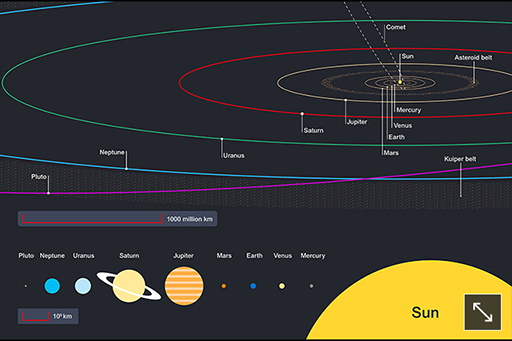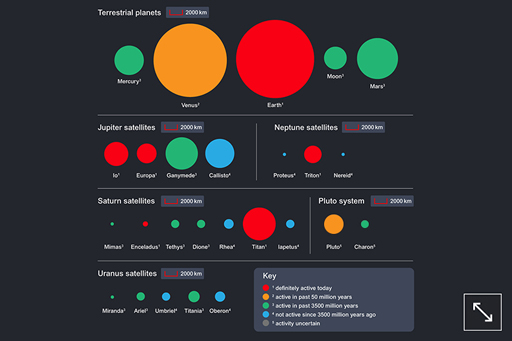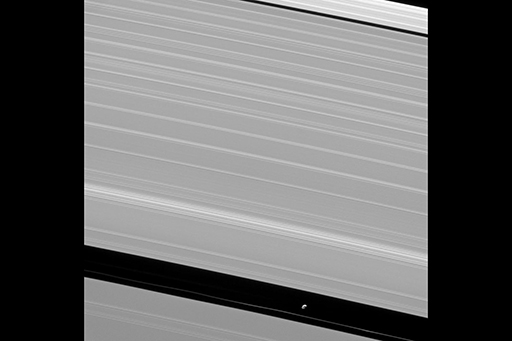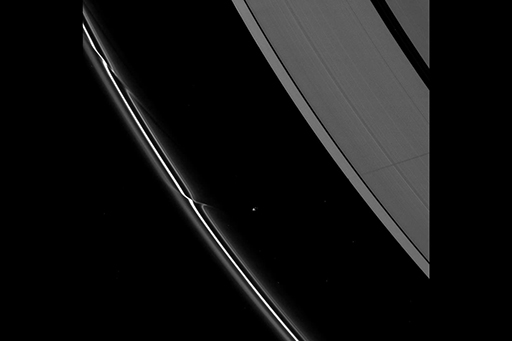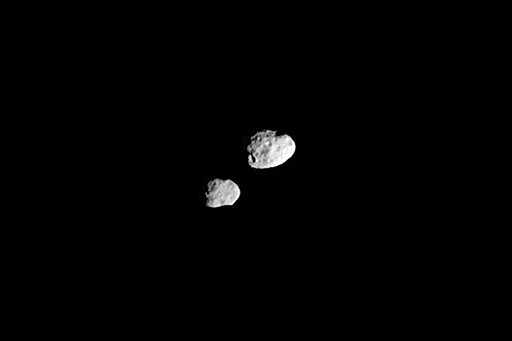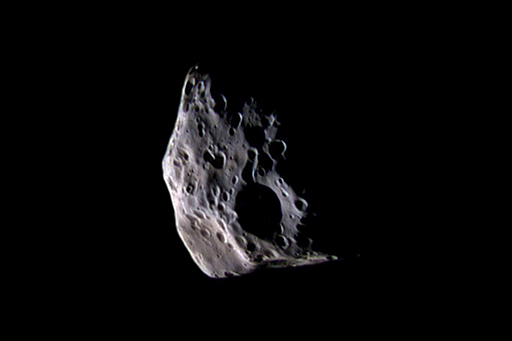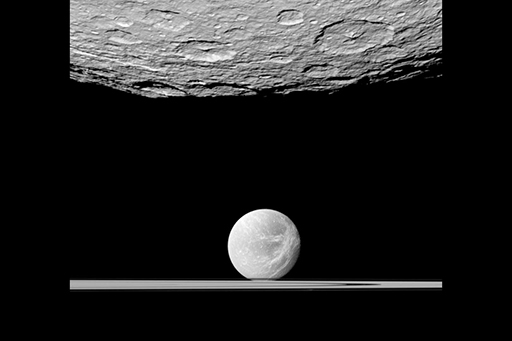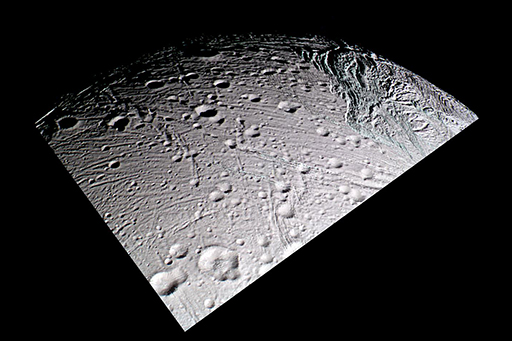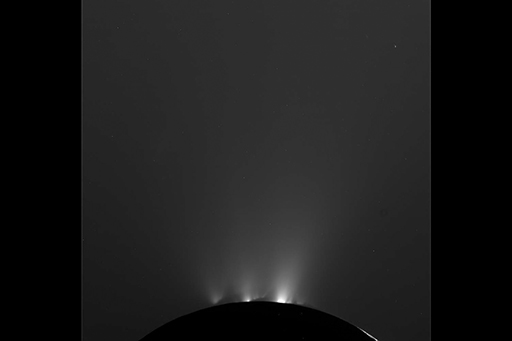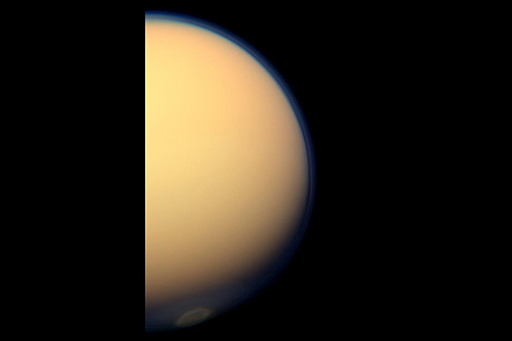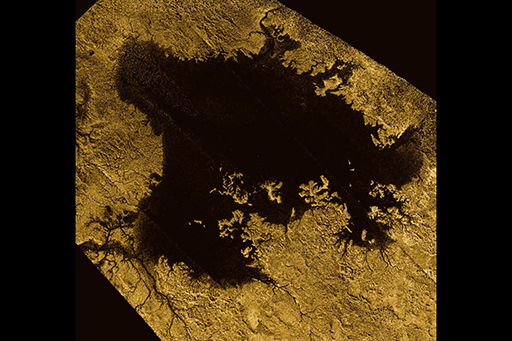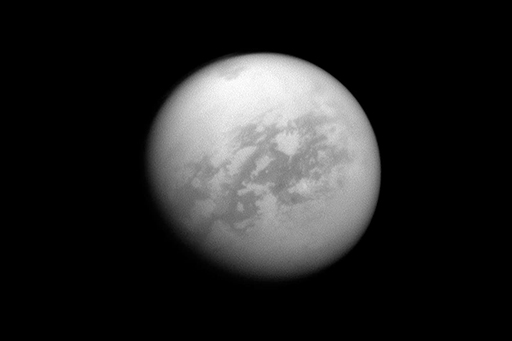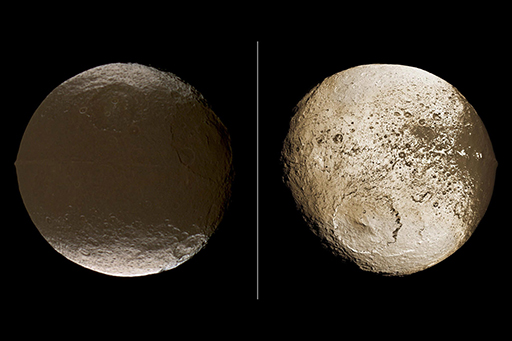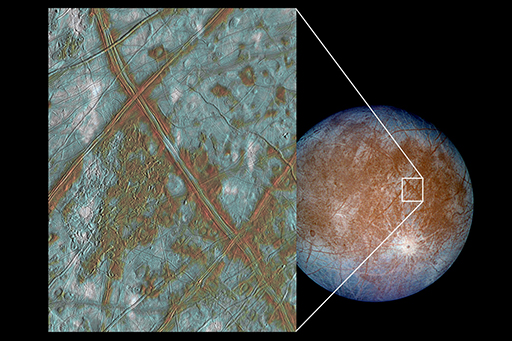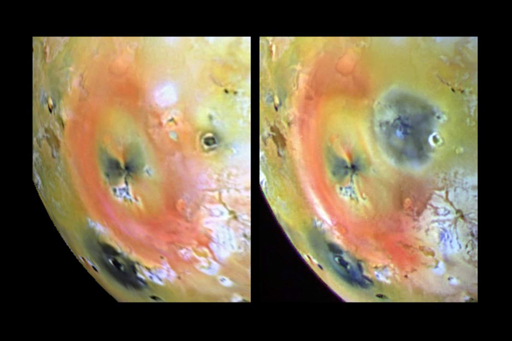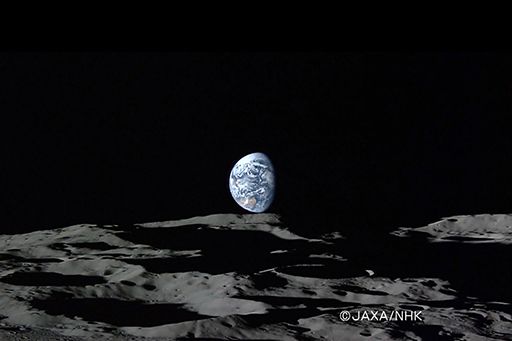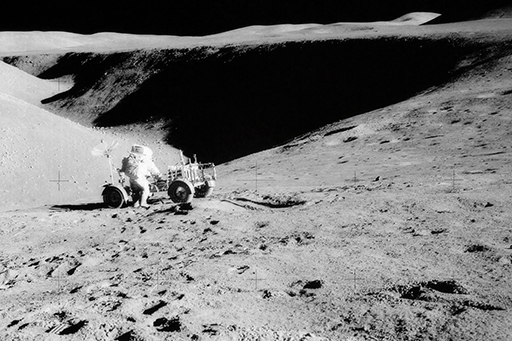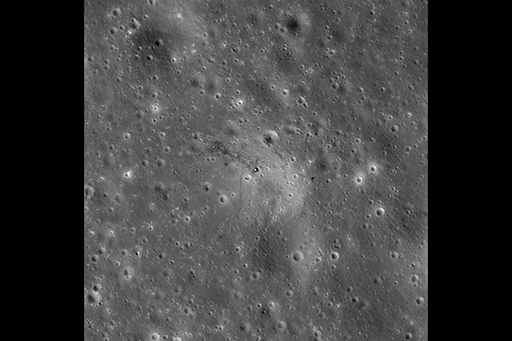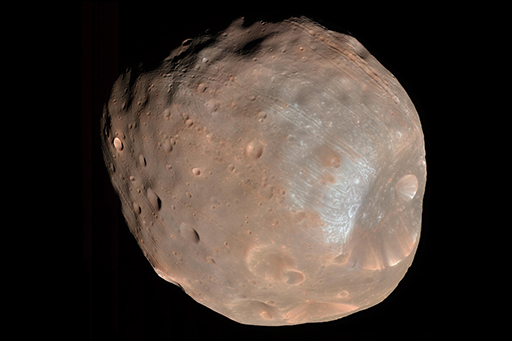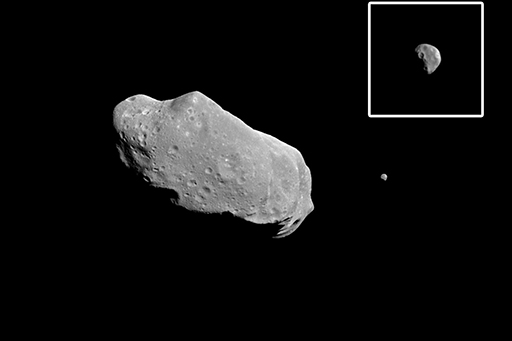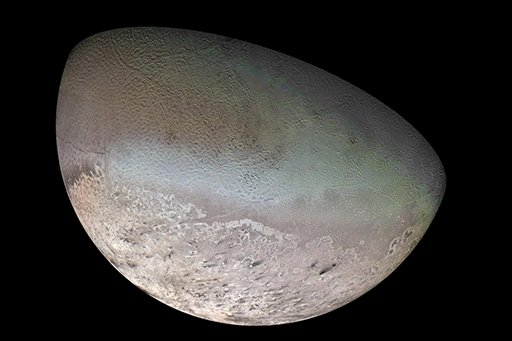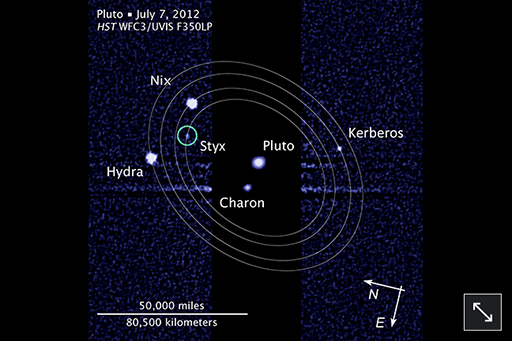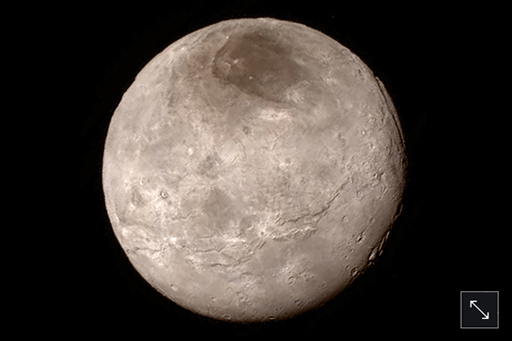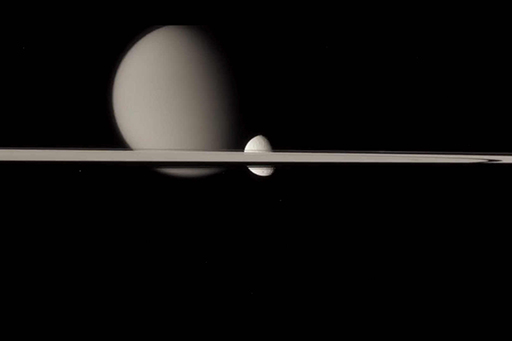1.4 The first picture show
You saw glimpses of several moons in the first video and you’ll find out more about many of them later. In the meantime, work your way through this image gallery to get a taste of some of what’s to come. We start by giving you a sense of scale (Figures 3 and 4), then you look at some of Saturn’s moons, which are a particularly spectacular and varied family, and then you whizz past just a few of the other moons in our Solar System.
The top of Figure 3 has a view of the Solar System looking obliquely across. The planets move anticlockwise in near-circular orbits, whose shapes are foreshortened in this perspective. So do the asteroids (concentrated between the orbits of Mars and Jupiter) and Kuiper Belt objects (mostly beyond Neptune). The Earth’s orbit is 150 million km from the Sun; Neptune is thirty times further out. The bottom of Figure 3 has the Sun, the eight planets and Pluto drawn with diameters (but not distances) to the scale shown.
Figure 4 shows the largest solid bodies in the Solar System, colour-coded according to how recently there has been significant internal geological activity (known or likely). This shows all the large moons on the same scale as the Earth-like (terrestrial) planets. You can see that Ganymede is slightly bigger than the planet Mercury; however, it is made partly of ice whereas Mercury has a large, dense, iron core and so has more than twice the mass of Ganymede.
Saturn’s rings are made of myriads of brick-sized lumps of ice, individually too small to be regarded as moons. However, there are some genuine moons among the rings. In Figure 5, captured by the Cassini orbiter in 2013, you can see Pan, a 28-km long ‘shepherd moon’ whose orbit lies in a 325-km wide gap in the rings.
Figure 6 was captured looking south onto Saturn’s rings by the Cassini orbiter in 2009, when Saturn’s ring-plane was almost exactly edge-on to the Sun. It shows the 86-km long moon Prometheus and its very elongated shadow cast onto the rings to its right (faint thin line crossing the wide grey ring about halfway up the image). To its left, you can see the disturbances in a narrow ring (called the F-ring) caused by the gravitational attraction of Prometheus which is orbiting anticlockwise, faster than the particles in the F-ring.
A few moons actually swap orbits. Figure 7 shows Janus (right) and Epimetheus (left) as seen in 2006 by the Cassini orbiter. Janus is 203 km long and Epimetheus is 130 km long. They look similar in size because in this view Janus was further away (492 000 km, whereas Epimetheus was only 452 000 km away). One orbits slightly closer to Saturn than the other, but about every four years they swap over.
Figure 8 is a close-up colour view of Epimetheus, imaged by the Cassini orbiter from a range of 74 600 km. The large crater in the lower centre, Hilairea, is 33 km across.
Figure 9 is a Cassini orbiter image with the south polar region of Saturn’s second-largest moon Rhea (1527 km in diameter and heavily cratered) in the foreground. Beyond it is a foreshortened view of part of Saturn’s rings (the planet itself is out of shot to the left) and beyond them Dione (1123 km in diameter). Rhea and Dione are large enough for their own gravity to pull them into spherical shapes, unlike the smaller moons in the earlier images.
Figure 10 is a colour close-up of part of Enceladus, one of the smallest spherical moons of Saturn. The largest crater in this view is about 20 km across. Many of the craters have been cut by fractures and at the upper right is a region so heavily fractured that no traces of craters remain.
Figure 11 is a Cassini image looking at the night side of Enceladus, at the bottom. Jets of ice particles spout from cracks near the moon’s south pole and catch the sunlight as they rise above the surface.
Titan is Saturn’s largest moon, 5151 km in diameter and the only moon in the Solar System to have a dense atmosphere. This natural-colour image from the Cassini orbiter (Figure 12) shows the dense orange hydrocarbon smog with a blue haze layer above. A vortex pattern lies above the south pole. To see the surface of Titan, either special filters are used to accept only the wavelengths of light that the smog does not affect, or radar is used to penetrate to the surface.
And here (Figure 13) is what radar shows through all Titan’s haze – rugged terrain with rivers feeding into large lakes. This one, named Ligeia Mare, is in Titan’s north polar region. The lake is probably mostly liquid methane. The rugged terrain is water-ice, behaving like rock.
Figure 14 is the best sort of view you can get of Titan’s surface from a distance without using radar. Cassini recorded this using a narrow-band near-infrared filter to accept light at 938 nanometres wavelength, which is just about able to penetrate the haze. The dark patch near the north is a large lake called Kraken Mare that has been imaged by radar. The equatorial dark patches may be dry sea-beds, but have no liquid at present.
This is Iapetus (Figure 15), 1470 km in diameter. It is Saturn’s outermost large satellite and was discovered in 1671 by Giovanni Domenico Cassini (after whom the Cassini orbiter spacecraft is named). All Cassini could see of Iapetus through his telescope was a tiny speck of light, but he noted that it is always much fainter when on one side of Saturn than when on the other. From this simple observation, he correctly surmised that Iapetus keeps the same face towards Saturn throughout its orbit and that its leading hemisphere must be much darker than its trailing hemisphere. You will soon discover that most moons do keep the same face towards the object they are orbiting. However, Iapetus’ asymmetric brightness is unusual. The side that always faces forward as Iapetus moves round its orbit (its leading hemisphere) has become coated in dark, reddish dust collected from space. The other side is highly reflective ice.
This is arguably the place in the Solar System, beyond the Earth, most likely to host life. It is not Mars, but a moon of Jupiter called Europa (Figure 16). It is only slightly smaller than our Moon and it is probably made of similar stuff except that it has an outer layer of ice. The way the icy surface has become cracked and shunted around suggests that there is a liquid water layer between the solid icy shell and the rocky interior. The images used here were recorded by NASA’s Galileo orbiter in 1996 and 1997.
The most volcanically active body in the Solar System is Jupiter’s moon Io (Figure 17). It is a fraction bigger than our Moon and is the only other large moon to have a rocky, rather than icy, surface. It is coloured yellow by sulfur compounds. The two views here were recorded by NASA’s Galileo orbiter in April and September 1997. The large orange ring is fall-out from a previous eruption of the volcano Pele Patera. Note the grey deposit to its right, erupted from the volcano Pillan Patera between the dates of the two images.
Figure 18 might look like an artist’s impression for a science fiction story, but it is a genuine image sent back by a Japanese lunar orbiter called Kaguya (also known as SELENE) in December 2007. The view is across the lunar south pole and consequently the Earth is upside down too, with its South Pole towards the top. The shadow-filled crater below right of the Earth is named Shackleton and is 21 km in diameter. The lunar south pole is inside Shackleton, and the shadow within it, and inside some neighbouring craters, is permanent. There is good evidence that quantities of water-ice are mixed among the lunar soil (or regolith) in these permanently cold sites.
Figure 19 is one from the glory days of Apollo in 1971. Apollo 15 commander Dave Scott is seen beside the Lunar Roving Vehicle on the rim of a lunar valley, Hadley Rille, believed to have been formed by flowing lava. The rille snakes away northwards into the distance.
No one should be in any doubt that the Apollo landings were real. Figure 20 is the Apollo 15 landing site imaged from lunar orbit in March 2010 by the Lunar Reconnaissance Orbiter. Spacecraft from other nations have imaged the landing site too. Near the centre is the Apollo 15 ‘descent stage’, casting a shadow to its right. This was designed to be left on the surface when the ascent stage took off. Trails of scuffed-up regolith made by the astronauts on foot are dark lines. The twin wheel-tracks of the Lunar Roving Vehicle are harder to make out. The area shown is about 400 m across.
Figure 21 is Phobos, the larger of the two small moons of Mars. It is only 22 km long and is almost certainly an asteroid captured into orbit about Mars. Several sets of grooves cut across the surface and are thought to be the trails made when Phobos passed through hails of debris thrown up by impacts on Mars, only about 6000 km away.
This was an unexpected discovery. When the Jupiter-bound Galileo probe flew past the 54-km long asteroid 243 Ida in September 1993 it recorded a series of images. It was not until some of the last were downloaded five months later that Ida’s 1.6-km wide moon, now named Dactyl, was noticed. Figure 22 is an image of Ida and Dactyl, with a higher resolution enlarged view of Dactyl shown in the upper right. In the twenty years since then, about 150 moons of asteroids have been discovered and seven asteroids are known to have two moons each.
The most distant moon yet to be seen in close-up. Figure 23 is Triton, the largest moon of Neptune. It has a thin, nitrogen atmosphere and seasonal polar caps of nitrogen-ice. Only the south polar cap is visible here, because the northern one was in seasonal darkness. Beyond the polar cap is a richly textured surface formed largely by icy volcanism.
Here are the five known moons of Pluto (Figure 24), imaged by the Hubble Space Telescope in 2012. Charon’s diameter, about 1200 km, is over half that of Pluto. The other moons are much smaller and only appear large because of the long exposure used to reveal the smallest, Styx, which is less than 25 km across. Their orbits are almost circular but are foreshortened by the angle of viewing.
Here is Charon as revealed close-up when NASA’s New Horizons mission flew by in July 2015 (Figure 25). It is notable for the large-scale fractures that cross the disk.
If you wanted to look into this further, you might find the following links of interest:
- Apollo 15 landing site flipbook [Tip: hold Ctrl and click a link to open it in a new tab. (Hide tip)] . Visit this link for a ‘flip book’ series of images made at different times of day, allowing you to see the shadows changing.
- New Horizons. Find many amazing images from the New Horizons mission here.
- Oct-Dec 2015 final flybys of Enceladus. NASA’s Cassini probe’s final 3 flybys of Enceladus. On 14 Oct it saw the N polar region in detail for the first time. On 28 Oct it passed only 49 km above the S polar region to sample the eruption plumes.
Next it’s time for a Waltz Around Saturn (as seen in Figure 26), a video in the next section that was compiled from a sequence of images like this one, taken during Cassini’s orbital tour.

